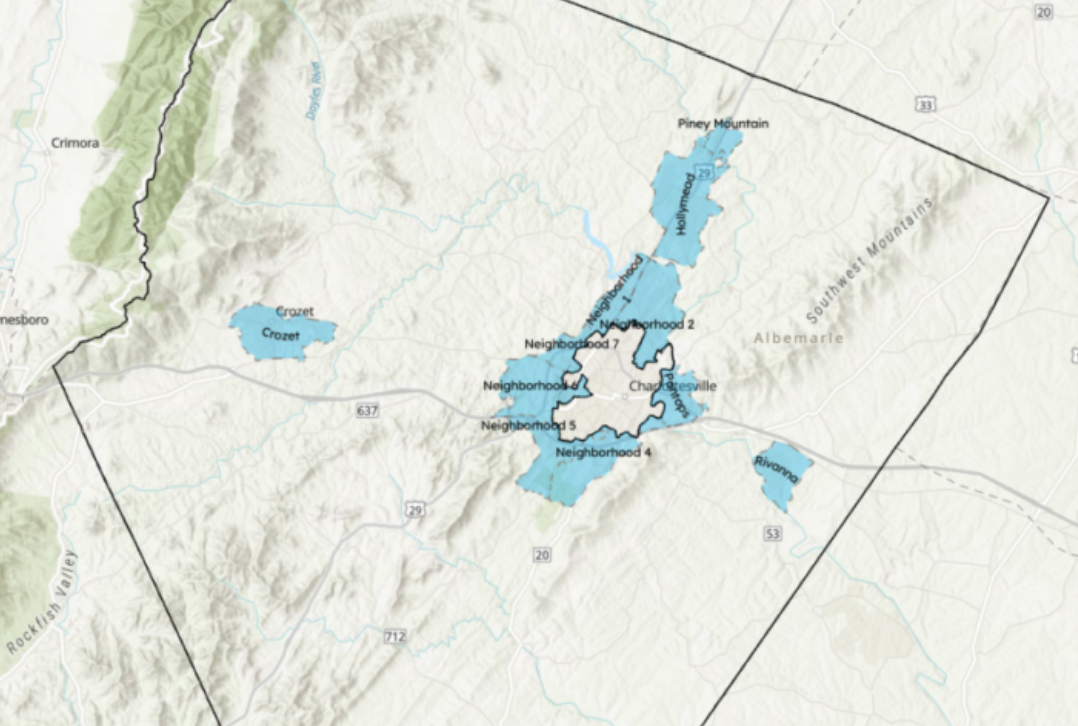For decades Albemarle has put a premium on protecting rural land by concentrating development in about 5 percent of the county’s 726 square miles. But as the review of the Comprehensive Plan continues, community members are being asked to weigh in on where future development might go.
“There will be places that we recognize it’s not appropriate to grow in the county,” said interim Director of Planning Kevin McDermott at a recent virtual meeting on what’s called the AC44 process. “But we have to keep the option open because if not there could be repercussions to not allowing any future development as well that might hurt the county.”
Since adoption of the last Comprehensive Plan in 2015, Albemarle supervisors have approved a housing plan that encourages the construction of thousands of homes. The county also adopted its first economic development plan as well as a climate action plan.
And then there’s the matter of a growing population. The Weldon Cooper Center for Public Service at the University of Virginia projects a 2040 county population of 138,523, with that climbing to 155,102 10 years later. That’s up from an estimate of 115,495 in July 2022.
The current plan review asks where and when more land might be designated for supporting density.
“The 2015 [Comprehensive] Plan estimated that about 11 percent of the development area’s land had capacity for development or redevelopment,” says Senior Planner Tori Kanellopoulos. “With the 2022 land use build out analysis, the estimated remaining development area land is about 7 percent.”
According to McDermott, any expansion would avoid natural resources, and likely areas in the water supply watershed. He says one place to start might be areas of “stale zoning,” where uses are allowed outside of the development area but have not yet been built on due to a variety of factors.
“As the cost of housing goes up, we can control some of those factors by allowing additional development that goes beyond the current development area,” McDermott says. “And we don’t want to start losing too many job opportunities in the county because we don’t have places where businesses can come and locate and grow in the county.”
Planning Commissioner Lonnie Murray pushed back on the need for additional space, saying that Albemarle’s development area is much larger than the total area of the city it surrounds.
“Charlottesville is only 10 square miles or approximately 6,500 acres,” Murray says. “Albemarle’s growth area is 23,680 acres, or 3.5 times the size of Charlottesville. If we look at Charlottesville, I would say that nobody reasonably believes that Charlottesville has run out of space yet.”
Sally Thomas served four terms on the Albemarle Board of Supervisors during an era when economic development was not encouraged by the county government. She says a reason for the development area has been to direct limited resources into a concentrated area in order to make provision of services more likely.
“To have the transportation available for example is much more possible when you’re not stretching out all out across the countryside,” Thomas says. “And it’s pretty well proven that additional development doesn’t guarantee lower cost housing.”
One concern is that if the growth area is expanded prematurely, it will make it less likely that those existing commercial spaces will be redeveloped.
Dick Ruffin, the chair of the Pantops Community Advisory Committee, says, “We already have some potential commercial spaces which are not being developed. We have a large shopping center, which is very poorly developed, and much better use could be made of it.”
Expanding the county’s growth area boundaries will be discussed at the August 8 Albemarle Planning Commission meeting.
